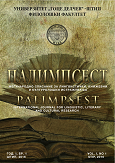STRATEGIE DISCORSIVE DELL’INFORMAZIONE TELEVISIVA NEL DISCORSO SULLE MIGRAZIONI, ALCUNI APPUNTI LINGUISTICI SUL CASO ITALIANO
DISCOURSIVE STRATEGIES OF THE TV INFORMATION IN THE DISCOURSE ABOUT MIGRATIONS, SOME LINGUISTIC POINTS REGARDING THE ITALIAN CASE
Author(s): Paolo OrrùSubject(s): Applied Linguistics, Semantics, Sociolinguistics
Published by: Универзитет »Гоце Делчев« - Штип
Keywords: discourse; migrations; racism; mass media; documentary.
Summary/Abstract: Mass media and journalism played an important role in the reproduction of stereotypes and biased interpretation of the migratory phenomenon. The main goal of this contribution is to verify the consistency of the discourse about migration in Italian journalism over different media. Therefore, in this study the authors will focus on documentaries screened by the Italian National Public Television (Rai). The corpus is composed by three movies: two by Valerio Cataldi and one by Amedeo Ricucci. Cataldi’s movies were produced and aired by Tg2 under the patronage of UNHCR (United Nations High Commissioner for Refugees). They depict two different aspects of migrants’ experience. In La neve la prima volta, the author focuses on the stories of four survivors from the Lampedusa dump occurred on 3 October 2013, which caused 366 deaths. Quando Youssef si mise in cammino narrates the story of Yousef and his three friends in their journey from Afghanistan to Austria in search of asylum. Similarly, La lunga marcia by Amedeo Ricucci follows the journey of Syrian refugees in their attempt to reach Europe during summer of 2015. The three movies cross a wide set of issues regarding migration in Italy and the EU, such as the construction of European external and internal borders; policies and practices of migrant management; human rights; racism and prejudice towards foreigners. The main goal of the contribution is to employ the means of discourse analysis to reflect on multimodal discourse about migration and its role in the social construction of refugees and migrants.
Journal: Палимпсест, Меѓународно списание за лингвистички, книжевни и културолошки истражувања
- Issue Year: 1/2016
- Issue No: 1
- Page Range: 37-52
- Page Count: 16
- Language: Italian

